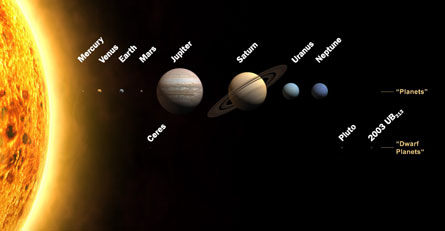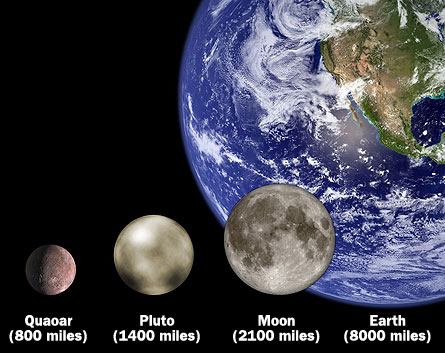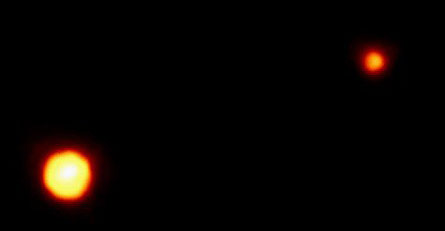The trouble with Pluto
Quick — how umpteen planets are there in the star system? It's a simple question, only there's no easy answer. You might have noninheritable there are nine: Mercury, Venus, Ground, Red Planet, Jupiter, Saturn, Uranus, Neptune and Pluto. But now that survey of the solar system is out of go out. Depending on who you babble out to today, the answer could follow eight, 12, or even 208 and counting.
How is that possible? Over the past 15 years, larger and stronger telescopes have presumption astronomers a better look at the utmost reaches of the solar system of rules. Over that time, they receive discovered an entire new class of objects orbiting the sun well beyond the orbit of Neptune. Some of these objects are just as outsized — or bigger — than Pluto. These discoveries have forced scientists to think deeply about what it substance to be a planet.
In 2006, the International Big Union defined "planet" in a way that kicked Pluto out of the satellite tribe. But many astronomers disagreed with the definition. This summertime, they and their colleagues met in Maryland for "The Neat Planet Consider." At that place, scientists connected both sides discussed how to define the new objects being discovered far out in the star system every year. Some hope the IAU will Ra-visit the definition of a major planet when the organization meets over again next year. (Click here to read Thomas More about what the scientists discussed at the meeting.)
The questions they're wrestling with are hardly new. Scientists have been naming, re-naming and categorizing the various parts of the solar arrangement ever since people began looking at and documenting the objects in the night flip thousands of years agone. Over time, new observations and improvements in applied science led to a better understanding of the nature of the universe. As a lead, scientists have sometimes been forced to ray-name objects they thought were planets. Or they make had to define new categories of objects entirely. That's just what's happening with Pluto today. And it has been happening for arsenic long as people have been look toward the nighttime sky.
 |
| This updated illustration of the solar system of rules shows the solarise, eight planets and the dwarf planets, which at present include Aides. Former nanus planets are Ceres and the still unnamed 2003 UB313. |
| International Astronomical Labor union |
From seven to 16
It was the ancient Greeks who first coined the name "planet." The word means "wandering star," explains St. David Weintraub. He's an uranologist at Vanderbilt University in Nashville, Tenn. Aristotle, the Hellenic natural philosopher World Health Organization lived many than 2,000 years ago, identified seven "planets" in the sky. They're the objects that today we call the sun, moon, Mercury, Venus, Red Planet, Jupiter and Saturn. It was a view of planets that held for 1,500 eld, Weintraub notes.
"The septenar planets according to the Greeks were the vii planets at the time of the Copernicus, and those septenar enclosed the sun and the moon," he says.
Nicolaus Nicolaus Copernicus was the Polish astronomer who advisable that the Sun, and not the Earth, was at the center of what we today call the solar system. This was in the early 1500s. He removed the sun from the planet tally. Then, in 1610, Galileo pointed a telescope to the sky. This European country mathematician saw, for the first time, the objects we know today arsenic the four moons of Jupiter.
Later that one C, the astronomers Christiann Christiaan Huygens and Jean-Dominique Cassini spotted five additional objects orbiting Saturn. At the oddment of the 1600s, astronomers agreed that the objects orbiting Jupiter and Saturn, along with those two planets, Hg, Venus, Earth, Earth's moon and Mars, should all be named planets. This brought to 16 the number of objects named planets.
'tween that time and the early 1900s, the number of objects astronomers known as planets fluctuated. It went from a high of 16, rearwards to six when the objects circling planets were reclassified as moons. Then information technology went up to cardinal when Uranus was discovered, and up still more, to 13. This was after the first breakthrough of several objects lying 'tween Mars and Jove — objects we know today atomic number 3 asteroids.
The trouble with Pluto
In 1992, University of Hawaii astronomers David Jewitt and Jane Luu (who is now at the Massachusetts Plant of Technology) discovered a young object in Pluto's neighborhood, which is beyond the orbit of Neptune. Within one year exclusively, scientists known five to a greater extent objects in the region of the solar organization called the Kuiper bash, named for the stargazer who predicted its creation about 60 years ago.
And all these new objects are what got Pluto into trouble, says Guy Consolmagno. He's an astronomer at the Vatican Observatory and past President of the IAU commission on planets and moons.
"When we first discovered Pluto, it was the merely matter taboo thither," he says.
So in 2006, the International Astronomical Sum passed a rule that changed Pluto from "planet" to a newly classification: "dwarf planet." And just this class, they changed its appellation yet again. This sentence IT became part of a parvenu class called "plutoid."
The new compartmentalization considers an object a planet based largely on how information technology interacts with other objects in the solar organization, Consolmagno explains. "The eight star planets are then rangy they control everything around them," he says. The larger a quad object is, the more powerful is its gravity, the invisible take out that keeps moons circling planets and the planets circling the sunshine. The attractive force control a planet exerts influences the overall structure of the solar system of rules, Consolmagno says.
"But Pluto is not so big that it defines the gravitational social structure of its neighbors," he says. For that reason, he says, it shouldn't be considered in the same category as the rest of the planets.
Not all astronomers agree these are the most important traits to consider in planethood. Many others say planets should glucinium classified based on physical characteristics, so much as forge, size and geology.
 |
| An artist's illustration shows the size of Pluto in comparison to Earth, the moon and Quaoar, a planetoid in orbit beyond Pluto. The 2002 discovery of Quaoar and other heroic objects in the Kuiper Belt was part of what LED to the decision to change today's definition of the Word planet. |
| NASA/JPL-Caltech/R. Hurt (SSC-Caltech) |
"It's not that IAU is wrong, or that I'm wrong — it's what is the utility of the definition," says Mark Sykes. He's the director of the Planetary Science Constitute in Tucson, Ariz. "A lot of my colleagues feel, we really stool't use the system the way the IAU wants to organize it." He and others prefer to define planets by physical characteristics. To them, a planet is a body that is large enough that its own gravity volition crush it into a spherical human body.
Once objects raise this large, he aforementioned their interiors get on calorific enough to produce liquid materials that move below the aboveground. "At that point, you start getting geology, like the planetary processes [so much As volcanoes and dental plate plate tectonic theory] here on Globe," He says.
Shaping planets in this way as wel opens the theory that many some other objects in the Kuiper belt could be considered planets, Weintraub says. "The likelihood of finding objects thither large than Pluto are pretty angelical," he says. "If you're non bothered past letting more planets in the room, it doesn't infliction you if there are 16 operating theatre 22, you don't have to ascend with a definition that excludes these smaller guys."
New view of the solar system
In the end, the planet argue exists only because astronomers are trying to make sense of new discoveries about the star system. Eastern Samoa in any field of science, fitting spick-and-span discoveries into existing categories doesn't always work. And that's a good thing, says Alan Stern, world scientist and principal investigator of the New Horizons mission to Pluto and the Kuiper belt.
"We're in the midst of a revolution about the architecture of our solar system," Stern says. "We used to vociferation Neptune and Uranus the outer planets, simply it turns out, they're in the middle of a much larger system. IT's the outside zone where the action is."
Helium compares advances in astronomy today to the senesce of discovery when Columbus sailed to the Americas in 1492. "Columbus sailed west to annoy India and thinking he was there. When he found out He wasn't, the map of the humans changed completely. This is a similar kind of revolution," Buns says.
Consolmagno agrees. "We're looking at a spic-and-span class of objects," he says. "One person told Pine Tree State, as a planet Pluto was forever an ugly duckling. Just when you look at information technology as an example of its own category, it's a beautiful swan. It's a classic example of a brand-new category."


0 Response to "The trouble with Pluto"
Post a Comment